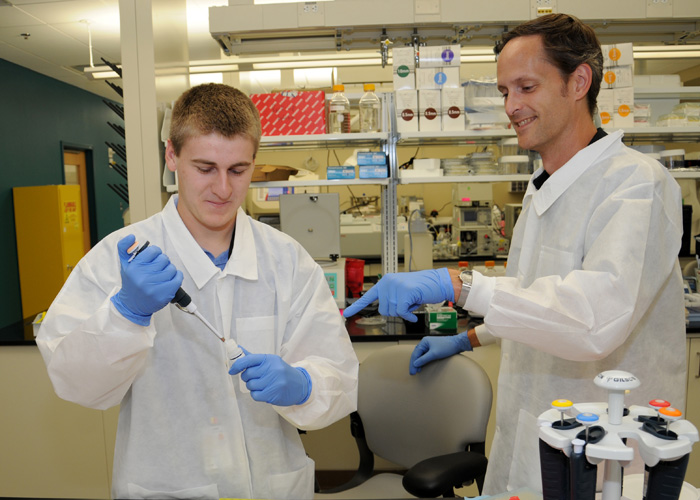College Interns Introduced to Combat Casualty Care Research

While some college students spent their summers relaxing and recharging by the pool or beach, nine undergraduate students completed 10-week internships conducting combat casualty care research with the U.S. Army Institute of Surgical Research.
"The purpose of this program is to give students exposure to the lab environment and invaluable research experience," USAISR Staff Scientist and Lead Intern Mentor David M. Burmeister, Ph.D., said. "Hopefully this not only helps them clarify what their goals and aspirations are for the future, but also facilitates reaching those goals."
The interns were paired up with USAISR researchers who served as mentors to work on projects to further the Institute's mission of optimizing combat casualty care.
"This program introduces Army programmatic research to students who are interested in careers in science and medicine," USAISR Deputy Director of Research Maj. Stuart Tyner said. "Unlike an academic research setting, the research performed at the USAISR is geared towards solving a military-important medical threat and develops products, things or knowledge that solves that problem."
Sean Christy, a sophomore biology major at Southwestern University, was assigned to do research with microbiologist Lloyd Rose, Ph.D., at the USAISR Dental and Trauma Research Detachment. Christy's project involved the use of skin cells and the healing process after a burn.
"I'm taking samples of tissue to determine what happens to genes that lead to good or bad healing," Christy said.
Rose added that genes play a major role in how a burn patient heals and the scarring associated with the healing.
"Every burn patient heals different," Rose said. "We're breaking down the genes to determine what it is in the DNA that determines the healing and scarring pattern."
Research runs in the family for Christy. Both of his parents hold doctorates and are involved in research. This is the second summer Christy has spent at the USAISR. He said he enjoys this type of research, and it is something he is going to pursue as a career.
"Yeah, I guess you could say it's in my blood," Christy said.
While research is something Christy has always been around, that is not the case for all interns. Claire Caldwell, a sophomore and chemistry major at Texas A&M University said she had no idea combat casualty care research existed. She learned about the USAISR undergraduate internship program by chance. While waiting at a barber shop for a friend to get a haircut she met the USAISR Joint Trauma System director of trauma care delivery, who told her about the program and suggested she apply for it.
She did, and was assigned to intern with the director of the JTS. Caldwell learned the JTS mission and how data is used to identify shortcomings in military medicine and care, and how to create new guidelines to improve those shortcomings.
"This has been a great opportunity for me," she said. "When I look at the data, I don't see numbers. These numbers represent people, and I get to work on a project that can save lives."
Caldwell, a cadet at Texas A&M University, has a contract to join the Air Force when she graduates. She said after having been exposed to combat casualty care research, she now has a new perspective on her career.
"Now I want to go to medical school," Caldwell said.
The interns' time at the USAISR included more than learning about combat casualty research. The interns attended weekly seminars; each intern led a journal club session and attended Burn Center rounds. Their summer work culminates with a poster presentation on the research they conducted.
"Everyone is welcome to stop by and see specifically what they have done this summer," Burmeister said. "They were extremely active in the lab and there was added benefit to advancing the research performed here."














